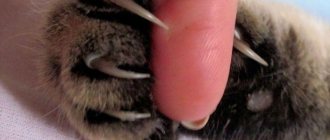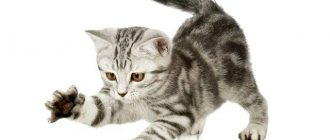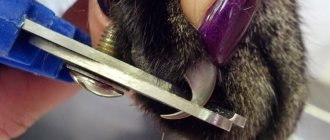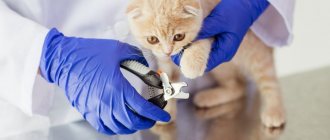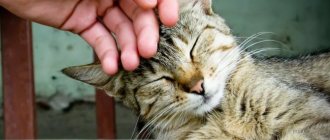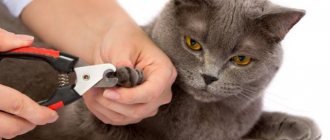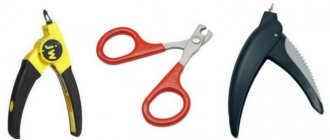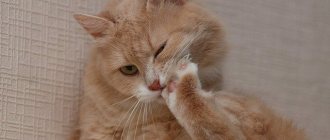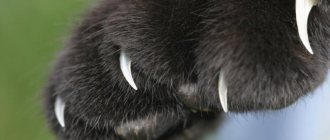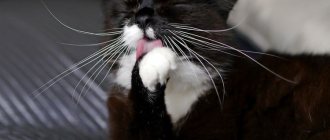The debate about whether it is worth trimming a cat's claws continues unabated. Some owners are categorical in their “no”, others defend the opposite point of view.
There can be many reasons for trimming the nails of your mustachioed and tailed pet:
- a cat injures a child with its claws,
- scratches furniture and wallpaper,
- brings back dirt on his claws from a walk, etc.
Yes, cats sharpen their claws on objects they like, and this is an important need for them - this way they grind off the overgrown part of the claw.
Cats can scratch a person playfully, and they do this not intentionally - this is a genetically determined behavior of cats.
So whether to cut or not to cut, each owner decides for himself, based on the possible risks.
What can you use to trim your cat's nails?
The market for professional cat grooming has become so vast and popular that it has become difficult to know what to choose and use. Manufacturers offer nail clippers of various designs and types, but you should pay attention to quality and sharpness.
- Side claw clipper. From Hanna Nursery recommends this type.
- Guillotine claw clipper.
- Nail clipper-scissors.
- Grinder is a tool with a grindstone (diamond coating).
- Nail file.
Regular human tweezers, clippers or scissors are not suitable for trimming nails.
There are owners who consider declawing operations normal. This is a barbaric operation, why you can’t do this - it removes the phalanx of the finger along with the claw, as a result - the animal becomes disabled, both physically and psychologically, balance when walking is impaired, it hurts the cat to step on its paws, even after many years, to participate Such animals are not allowed in exhibitions. I wonder how these owners would live without one phalanx on each of their fingers?
It is common to use soft claws. A less barbaric activity, but still. To fix the caps, glue is used on the trimmed claws. Manufacturers claim that this is the best alternative to declawing, is safe for cats, does not affect the cat’s behavior, and much more blah blah blah. It’s hard to imagine any cat that would be glad that she had plastic hooks attached to her, her movements were constrained, how will her pet scratch herself and walk?
We humans must be responsible, take care of those we have tamed.
Need to trim your dog's nails?
Many dog owners are unsure whether their pet's nails should be trimmed. There is an opinion that such a procedure is necessary only for decorative dogs. In fact, animals kept in an apartment cannot fully grind off their claws naturally. To do this, they need to walk a lot on concrete, asphalt and other hard surfaces. The nail plate is constantly growing, and overgrown claws begin to interfere with the animal’s ability to walk.
Veterinarians explain why this procedure is performed:
- long claws prevent the toes from coming together and cause pain to the pet, so when walking it places its paws incorrectly;
- the dog’s gait changes, joint deformation occurs and the functioning of the musculoskeletal system is disrupted;
- the vestigial claw on the fifth finger curls and grows into the soft tissue, causing severe pain;
- overgrown claws can peel off, cling to furniture or the owner’s clothes and break off; if an infection gets into the wound, inflammation develops;
- the dog can scratch furniture and flooring or accidentally injure a person with its claws while playing;
- In the house, the pet strongly clicks its claws on the floor, this is especially noticeable at night.
It is important to regularly trim the nails of decorative dogs, as well as representatives of inactive breeds. They don't move much outside and love to lie down. This increases the risk of ingrown or broken nails, so they need to be trimmed more often. But all breeds need to have their nails shortened.
How often should the procedure be performed?
Even a veterinarian cannot definitely say how often to shorten a dog’s nails. It depends on the breed, age, lifestyle. It is usually recommended to carry out the procedure as the claw grows. To do this, consider the appearance of the nail plate and evaluate the pet’s gait. The need for a haircut is indicated by the fact that the dog begins to click loudly on the floor, clinging to bedspreads and clothes.
But it’s better not to let things get to that point. Veterinarians warn that a blood vessel grows inside the claw along with the hard tissues. If you rarely shorten the nail plate, it will be closer to the tip, making it easier to injure when cutting.
At home or in the clinic
To carry out the procedure, you can contact a veterinary clinic. There, all dogs' nails are trimmed as quickly as possible, without discomfort or negative consequences. But many owners are not satisfied with this option. Although the procedure is inexpensive, it must be performed every month. The dog will have to be taken to the clinic, and for some this is a problem.
Many owners carry out nail trimming themselves at home. If you purchase the necessary tools and follow the recommendations of veterinarians, it is easy to do everything right. You can choose a convenient time, and the dog will behave calmly in familiar conditions.
How often and at what age to cut your hair?
Kittens are born with claws. It is not recommended to circumcise a kitten before 4 weeks of age; 2-3 months is considered the optimal age. Hooks help the baby learn to walk, climb, and not fly into a ditch when turning. Breeders accustom kittens to scratching posts from birth.
If the cat is domestic and very actively scratches the scratching post, then it is not necessary to trim it. Every week you need to monitor the condition of your cat's manicure. The claws on the hind paws grow more slowly than those on the front paws, and they are trimmed less often.
To avoid flakiness, the cat does not get out of the habit of the procedure, treats it calmly, it should be trimmed once every 2-3 weeks.
Structure of the claw
Before you trim your dog’s nails for the first time, you need to study their structure and shape. This is a full-fledged part of the paw. Dogs use them to maintain balance, protect themselves, cling to the surface with their claws when running, and dig the ground. Therefore, an incorrect haircut can cause harm.
The claw consists of two parts: a hard keratin layer and a claw bed. Inside there is a blood vessel and nerve endings. If you touch the nail bed while trimming, the dog will feel severe pain and bleeding will begin.
The keratin sheath is constantly growing and needs to be shortened. But if a dog's nails are trimmed infrequently, the blood vessel also lengthens and becomes closer to the tip. This makes it easier to damage and become infected. If you regularly trim your pet’s nails, the blood vessel goes deeper. This makes the procedure safer.
It is easy to see where the blood vessel is in dogs with light-colored nails. It can be seen in the light and it is immediately clear to what limit it can be cut. In breeds with black claws, the blood vessel is not visible, so it is more often injured when cutting.
When performing this procedure yourself, it is also important to study the shape of your dog's nails. There are three varieties:
- arched, slightly curved inward, characteristic of large breeds;
- strongly curved, cat-like, sometimes with sharp tips - found in service breeds;
- straight or hare, usually found in decorative breeds.
Accustom and prepare your cat for trimming
When a pet from an official nursery appears in the house, questions usually do not arise.
All training and preparation boil down to ensuring that the cat sits calmly in your arms; for this, we often pick it up, stroke it, and massage the paw pads. To make her friends with the nail clipper, let her sniff and touch her. The animal should be fed before the procedure; it should not be cut after playing. For the cat, the process should be calm and painless.
How to properly trim your nails at home
Trimming rules:
- The nail cutter should be positioned parallel to the claw, not at an angle or across, otherwise the cut will break the claw, resulting in peeling;
- We retreat from the pulp 2-3 mm;
- We make a cut at an acute angle, as shown in the figure;
- Cut off no more than 2-3 mm of the stratum corneum, 1-2 mm on the lower paws.
The photo below shows the rules for trimming claws, at what angle it is correct to do it, and where the sensitive (dangerous) area is located.
How are the claws of cats and cats arranged?
A cat's claws are sickle-shaped for capturing prey, climbing trees, or defending itself during a fight. The part that we see is penetrated almost to the very tip with nerve endings and vessels, and at the tip there is a keratinized part that is constantly renewed. It is to renew it that cats sharpen their claws.
By cutting even a small section of a cat's claw, you can, without meaning to, hurt the animal and injure the claw. Don't forget that after using the toilet, cats scrabble after themselves, and improperly trimmed claws can become infected. Infected claws lose strength, peel and cause discomfort to cats.
First aid
Unfortunately, no one is immune from injury, especially novice dog lovers. The hand trembles, the dog jerks sharply, or the length of the cut is incorrectly calculated and your pet will need help. That is why the materials necessary to provide it must also be prepared in advance and be at hand. This could be a special styptic powder, regular cornstarch or a simple bar of soap, hydrogen peroxide or chlorhexidine to disinfect the wound, bandages or napkins.
If your dog bleeds after trimming its nails, do not let your pet break free and run away from you. Try to calm him down, stroke him, pat him on the chest (this is the dog’s pleasure center). At the same time, begin to very carefully sprinkle the wound with powder or rub it with a cotton swab until the bleeding stops. If you use starch, sprinkle it on the wound, as rubbing can aggravate the situation and cause even more harm.
For minor damage, you can simply disinfect the wound with peroxide or chlorhexidine. You can also use a hemostatic pencil, which is pressed against the affected area of the claw for a few seconds and forms a dense clot that prevents further bleeding.
While providing first aid, offer the dog something tasty, try to distract him from what is happening as much as possible so that negative emotions do not become attached to the process of trimming his nails. Try to keep the dog calm for 15-20 minutes and not run, so as not to provoke re-bleeding.
If your pet reacts aggressively to an attempt to examine a wounded paw, the bleeding is excessive, or the dog continues to bleed 15 minutes after trimming its nails, contact your veterinarian immediately
If you are not sure that you can handle the procedure on your own or have not fully understood how to properly trim a dog’s nails with a nail clipper, you should entrust the procedure to a doctor or a professional in a grooming salon. As a last resort, ask for help from your household or those whom your pet knows well and is not afraid of. You can also consult with your veterinarian about taking sedatives for your dog before hygiene procedures. And remember, the calmer and more confident you are in your actions, the calmer and more trusting your pet will be.
Tips and tricks
Inexperienced owners are afraid to carry out the procedure for the first time. You can visit a veterinarian and learn from him. Or study the instructions and follow the advice of experts.
- For the procedure, choose a familiar environment. The dog should be calm and relaxed, not hungry. It's better to do this after a walk. If the animal is shy, there should be no strangers in the house.
- If the claws are black, it is difficult to determine where the blood vessel begins. Therefore, it is recommended to cut a few millimeters at a time.
- If the dog is nervous and tries to run away, it is better if another family member helps hold him. He should sit behind him and grab the pet by the neck with one hand and hold the paw with the other. It is important to stroke the dog and talk to it affectionately.
- Dogs have many sensory endings between their toes. Touching this delicate skin gives them an unpleasant sensation. Therefore, it is recommended to grab the finger not from the sides, but from above and below.
- It is especially important to exercise caution for pets with dark nails. The boundaries of the nail bed are not visible on them and it is easy to injure the vessel. Therefore, it is necessary to cut off little by little – a few millimeters at a time. It is recommended to stop when the tip stops flaking or becomes wet. You can focus on the hollow running below.
Your dog's nails need to be trimmed regularly. This is a mandatory hygienic procedure that will help avoid ingrowth and injury. If you don't take care of your pet's claws, they will grow back and cause discomfort. To carry out the procedure, it is important for the owner to prepare and follow the recommendations of veterinarians.
Teaching a dog to trim its nails
To make nail trimming stress-free for the dog and easy for the owner, the pet needs to be taught it from an early age. Puppies perceive hygiene procedures more easily and get used to them faster.
It is more difficult to train an adult dog. You need to choose a time when she is calm and not hungry. Caress, carefully take the paw, examine the claws. Then introduce your pet to the nail clipper and let him sniff the tool. If the dog is very timid, gently touch his fingers to show that there is nothing wrong. After this, try cutting off one claw. If the dog takes it calmly, be sure to praise him and give him a treat.
During the procedure you need to behave calmly. You cannot shout at the dog or scold it if it behaves badly or breaks out. There is no need to fuss or rush. It's better to try again the next day.
Estimated cost
Russian veterinarians are ready to perform an onychectomy on a cat for 1,500-10,000 rubles . Approximate cost of surgical manipulation depending on the number of limbs treated:
- Front paws only - 1500-6000 rubles .
- Front and hind legs - 3500-10000 rubles .
The table below shows the price list of popular veterinary clinics in the country for removing all claws from a cat.
| Name of the veterinary center | City where the veterinary clinic is located | Cost in rubles |
| Good Doctor | Moscow | 6000 |
| ZooVet | Ural | 3500 |
| Crane | Tolyatti | 4000 |
| Hope | Vologda | 3500 |
| Tailed pet | Saint Petersburg | 6000 |
| ZooVet24 | Moscow | 10000 |
The indicated prices include anesthesia and other materials necessary for successful surgical intervention.
What is required for the procedure?
Suitable tools are required to carry out the procedure correctly. Ordinary scissors will not work; you need to buy a special nail clipper. It is recommended to choose a tool carefully, taking into account the size and breed of the dog. It is worth paying attention to the following parameters:
- blade material – preferably brass or stainless steel, preferably with chrome plating;
- handles should be rubberized so that they do not slip;
- cast construction, fastened with reliable rivets;
- the tool should be comfortable to hold.
There are two types of nail clippers on sale. Secateurs that resemble scissors, only with a special blade shape. One of them is curved, the other is straight. Secateurs are convenient for small breeds; large dogs may not be able to handle the hard keratin layer.
A guillotine-type nail clipper is suitable for claws of any thickness. You just need to choose a tool that is suitable in size. This nail cutter consists of one blade with a hole. A claw is inserted into it and a lever-like handle is pressed. This is a professional tool, it is more difficult to use.
It is also recommended to purchase a file. With its help, they sharpen the claw, giving it the necessary shape, and smooth out irregularities. This helps prevent delamination. The file can be manual or electric. The machine is equipped with different attachments. If you choose a high-quality file, you can do without a nail clipper. Although many dogs are scared by the sound of an electric clipper, it also takes a lot of time to clean their nails with it.
Step-by-step instructions for trimming nails
Trimming your dog's nails is easy if you follow the instructions. First, prepare all the necessary tools and disinfect the blades. Just in case, prepare cotton pads, hydrogen peroxide, and means to stop bleeding. A nervous or fearful dog will need another treat. The pet's paws must be clean, without wounds or scratches. It is recommended to trim the fur between the toes in advance so that it does not interfere.
To do everything right, it is better to follow the step-by-step guide.
- Pet the pet, sit it down or lay it down so that it is comfortable.
- Take the paw in your hand and stroke it. Grab one dog's finger with your thumb and forefinger and apply a little pressure to the base of the claw, but do not squeeze too hard.
- Determine how long to cut, position the nail clipper at an angle of 45˚ from top to bottom.
- In one movement, cut the claw perpendicular to the direction of growth.
- Finish the cut with a file – remove nicks and round the edges.
In this way, cut off all the claws. It is recommended to start with the front paws. The rear ones are easier to work with when the pet is lying down. After the procedure, be sure to pet the dog, praise it and give it a treat.
Factors influencing the cost of veterinary services
Cat declawing can cost varying amounts of money. The cost of the operation depends on the influence of such factors:
- Method of manipulation.
- The number of paws that are declawed.
- Rating and popularity of the clinic.
- Availability of medical indications.
- General condition of the cat.
- The need to call a doctor at home.
- Difficulty in performing the manipulation.
- Qualification and experience of a veterinary doctor.
- Veterinary center pricing policy.
The region where veterinary services are provided also has a certain influence. In the capital and metropolitan areas, prices are higher than in sparsely populated cities.
